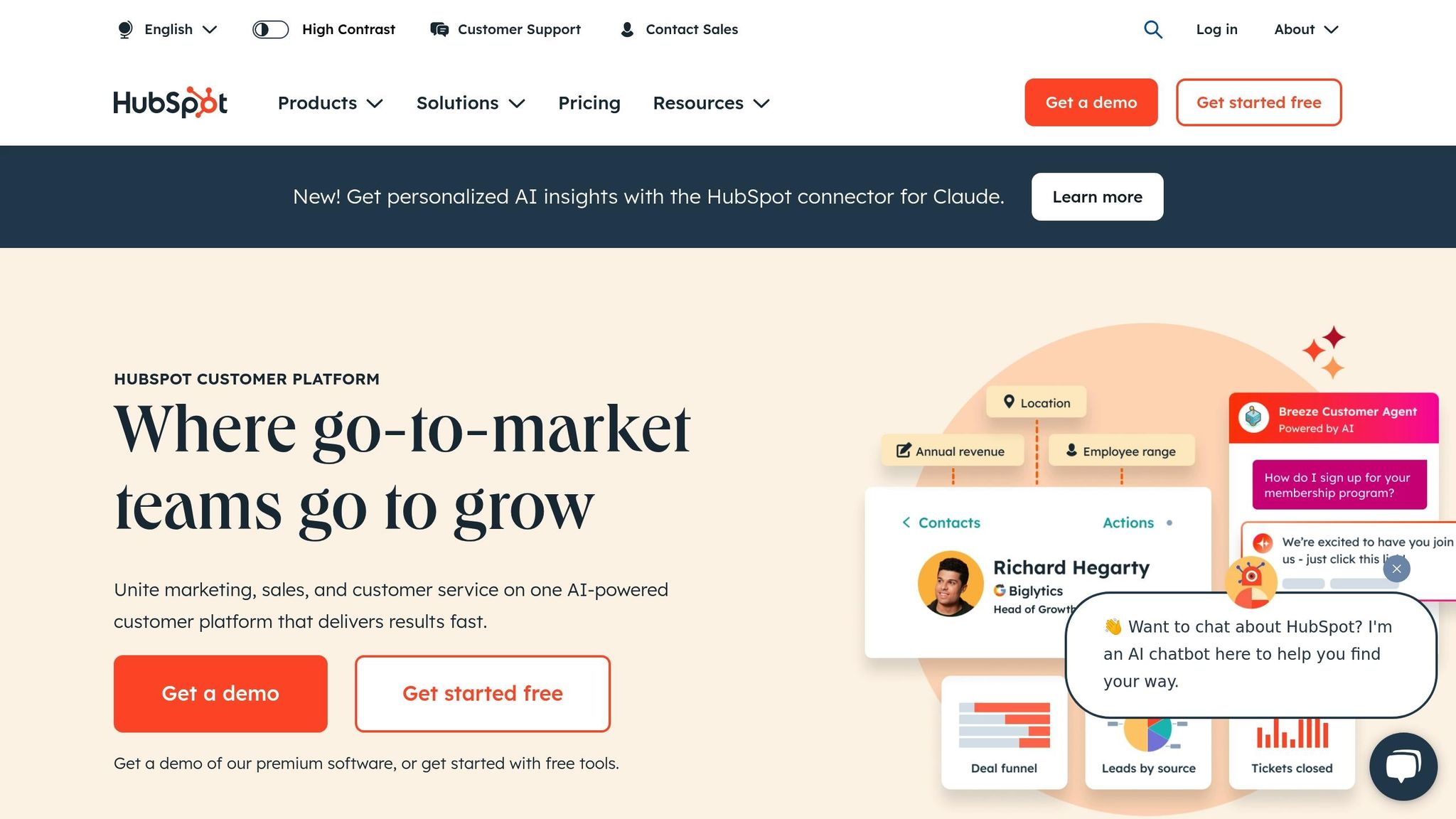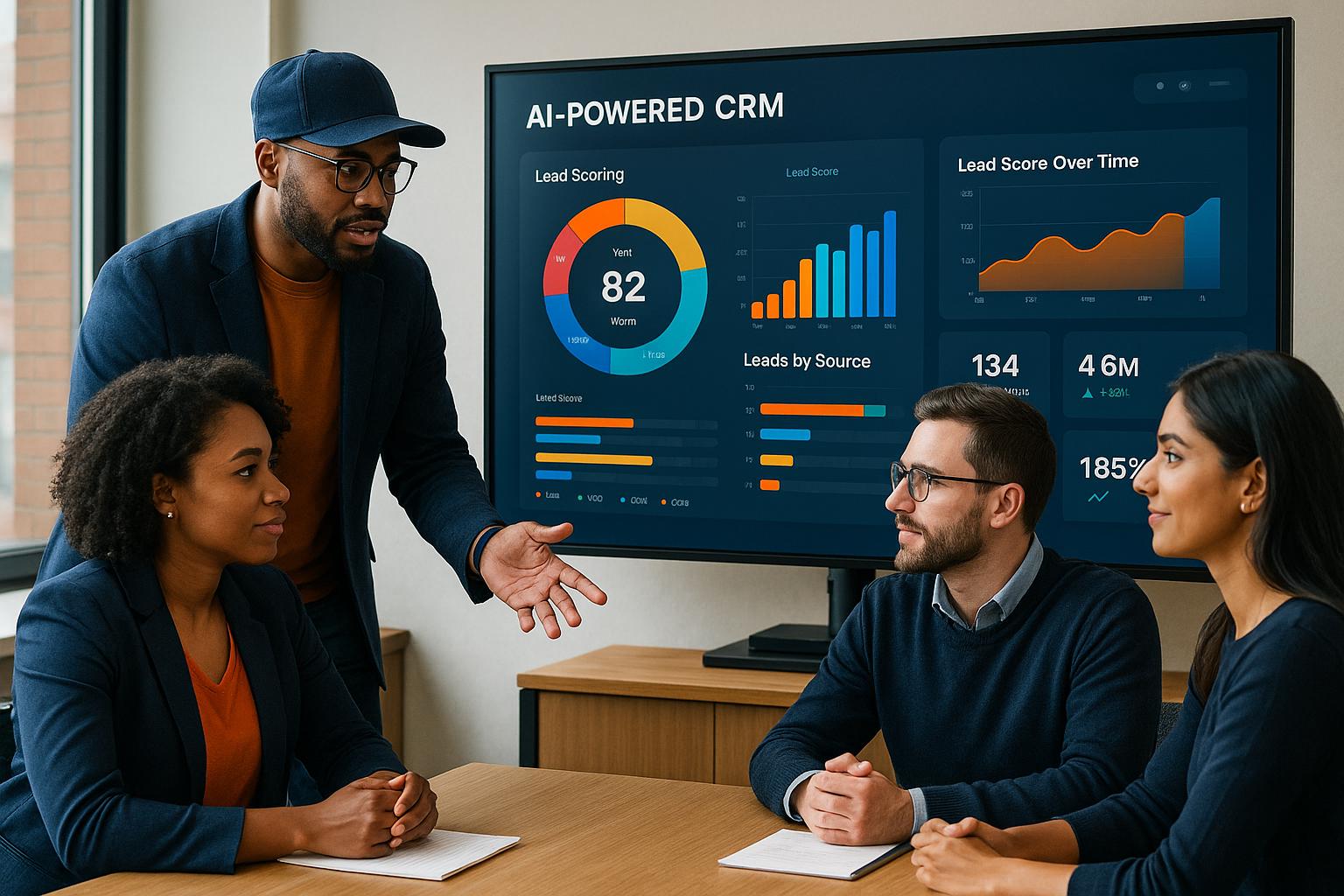AI is now the driving force behind smarter, faster, and more effective marketing campaigns. By automating complex processes, analyzing massive datasets, and delivering hyper-personalized messaging, AI has become essential for businesses aiming to stay competitive. Here’s what you need to know:
Key Takeaways:
- Multi-Channel Impact: Brands using AI to integrate email, SMS, push notifications, and other platforms report up to 287% higher conversion rates compared to single-channel efforts.
- Real-Time Optimization: AI tools adjust campaigns instantly based on live data, improving decision-making speed by 78% and forecasting accuracy by 47%.
- Personalization at Scale: Generative AI creates tailored content, boosting customer engagement by 25% and increasing lifetime value by 15%.
- Dynamic Budgeting: AI reallocates budgets in real time, increasing ROI by 15–30% in just a few months.
Challenges:
- Data Privacy: 70% of companies face hurdles with integrating data while adhering to privacy regulations.
- Implementation Costs: AI adoption requires upfront investment and time for optimization, which can deter some businesses.
Why It Matters:
With 88% of marketers now relying on AI daily, it’s no longer optional – it’s a necessity. Companies that embrace AI are seeing 300% ROI and faster growth, while those who don’t risk falling behind. Start small with AI pilots in areas like email personalization or predictive analytics, then scale as you see results.
The future of marketing is here, and it’s powered by AI.
7 AI Marketing Trends That Will Transform Your Business in 2025 | HubSpot Report

Key AI Technologies for Cross-Channel Scheduling
Transforming cross-channel campaign scheduling depends on three major AI technologies that are now driving measurable business results.
Machine Learning and Predictive Analytics
Machine learning algorithms uncover customer behavior patterns in historical data, predicting strategies with an accuracy rate of 85–95%.
This shift from reactive to proactive marketing is one of the biggest advantages of machine learning. Instead of waiting for campaign results, marketers can predict outcomes and fine-tune their strategies before launch. This approach has led to significant improvements across various industries.
Take Bayer‘s pharmaceutical division, for instance. By leveraging Google Trends data, climate insights, and Google Cloud‘s ML models, they forecasted regional flu outbreaks. Their system automatically adjusted creative content, media allocation, and budgets. The results? An 85% year-over-year increase in click-through rates, a 33% drop in cost-per-click, and a 2.6× boost in website traffic.
"The shift from manual measurement to algorithmic, real-time analysis allows near-instant adjustments to campaign parameters, fundamentally changing how we optimize for performance." – Single Grain
AI-powered campaigns consistently outperform traditional methods, with businesses reporting ROI improvements of 5–8× and conversion rate increases of 200–400%. Real-time data processing further enhances this by providing instant insights into market trends and customer behavior. AI tools can then make autonomous decisions, freeing marketing teams to focus on strategy.
Next up, Natural Language Processing (NLP) and generative AI take personalization to the next level by creating highly tailored content.
Natural Language Processing and Generative AI
Natural language processing and generative AI analyze customer data to craft personalized messages that connect on a deeper level.
Companies using generative AI for personalization see, on average, a 25% increase in conversion rates and a 15% growth in customer lifetime value. This technology allows brands to go beyond demographic targeting and deliver truly individualized experiences.
Here are some ways generative AI enhances cross-channel campaigns:
- Dynamic Content Creation: AI generates custom messages, images, and videos for specific audience segments. For example, in 2023, Carvana used AI to create 1.3 million unique videos tailored to individual customer journeys.
- Real-Time Sentiment Analysis: NLP evaluates customer emotions and feedback across channels, enabling marketers to adapt strategies. Businesses using sentiment analysis report up to a 25% improvement in customer satisfaction.
- Predictive Personalization: Instead of reacting to past behavior, AI anticipates customer needs and adjusts content dynamically, helping brands stay ahead of expectations.
Coca-Cola provides a clear example of generative AI’s potential. By deploying a personalization platform powered by AI, the company delivered tailored promotions and content across all channels, resulting in a 30% increase in sales and a 25% boost in customer engagement. Similarly, Unilever saw a 20% increase in customer lifetime value after implementing AI-driven personalization.
These technologies also enable autonomous personalization systems, which continuously learn from customer interactions to refine messaging, timing, and channel selection. This capability is becoming a cornerstone of cross-channel campaign scheduling.
Equally important is integrating AI into automation tools to streamline execution.
Integration with Automation Tools and Platforms
AI enhances marketing automation platforms by adding intelligence, creating systems that combine the dependability of traditional tools with AI’s decision-making power.
Modern AI-enabled platforms streamline cross-channel workflows through features like:
- Intelligent Email Marketing: AI personalizes email content based on customer data, boosting open rates by 25% and conversion rates by 30%. Emails sent at optimal times determined by AI see a 22% increase in open rates and a 20% rise in click-through rates.
- Automated Lead Scoring: AI analyzes lead data and behavior to identify prospects most likely to convert, helping sales teams focus on high-value opportunities.
- Smart Audience Targeting: AI digs into data to find the most relevant audiences, optimizing ad placement and targeting. This goes beyond demographics to include behavioral patterns, purchase intent, and engagement history.
- Omnichannel Messaging: AI-powered platforms send native messages across multiple channels – email, SMS, WhatsApp, push notifications, and in-app messages – by determining the best channel for each customer.
The e-commerce company Shinola, in partnership with ActiveCampaign, demonstrates the power of integration. Using AI-powered automation, they created an abandoned cart campaign that recovered over 20% of lost sales. The system identified abandoned carts, determined the best follow-up timing, and personalized recovery messages based on customer behavior.
Businesses using AI-driven email marketing platforms report a 15% increase in sales revenue on average. Additionally, companies leveraging AI-powered marketing analytics see a 25% boost in conversions and a 30% drop in customer acquisition costs.
"There is a saying going around now – and it is very true – that your job will not be taken by AI. It will be taken by a person who knows how to use AI. So, it is very important for marketers to know how to use AI." – Christina Inge, Instructor at the Harvard Division of Continuing Education
To successfully integrate AI, businesses need clear objectives, quality data, and tools that align with their needs and budgets. With proper training and support, marketing teams can harness AI’s potential while keeping strategic control over campaign performance. This integration is set to play a critical role in shaping cross-channel campaign scheduling by 2025.
Current Trends in AI-Driven Campaign Scheduling
With advancements in machine learning and generative AI, marketing campaigns in 2025 are more precise and impactful than ever. These technologies are reshaping how brands connect with audiences, delivering measurable results.
Personalized Multi-Channel Campaigns
AI is taking personalization to a whole new level, creating tailored customer experiences across multiple touchpoints. It’s no longer about targeting broad demographics – it’s about crafting unique, individualized journeys for each customer.
Here’s the proof: 91.9% of ecommerce and retail brands now personalize customer communications, achieving an impressive 89% retention rate, compared to just 33% for less integrated strategies. Multi-channel interactions also drive results, with spending increasing by 30%, and combining email with SMS marketing boosts conversion rates by up to 30%. Plus, more than 72% of consumers expect a seamless, multi-channel experience.
AI makes this possible by analyzing massive amounts of customer data in real time. It enables businesses to adjust messages and strategies on the fly, ensuring every interaction feels relevant and timely. This level of personalization sets the stage for campaigns that adapt in real time to customer behaviors.
Real-Time Data and Adaptive Decision-Making
AI’s ability to respond in real time is transforming how campaigns perform. By monitoring live data, AI systems can instantly tweak campaigns, delivering the right message at the right moment. This is critical, as 66% of consumers now expect real-time responses and interactions from brands.
Take Netflix, for example. The streaming giant uses AI to analyze user behavior and preferences in real time, optimizing content recommendations to keep viewers engaged and reduce churn. The impact is clear: 87% of marketers believe AI will significantly shape their strategies in the coming years.
"This is the year we’re seeing marketers upgrade from simple AI tools and use cases like chatbots and content generation or repurposing to intelligent agents like the Breeze Journey Automation agent. We’ve been pushing every marketing team at HubSpot to experiment, and the results have been incredible. Avoid thinking in limitations. Come up with ideas, and figure out a way to execute them. You might surprise yourself. I see this year as the year everyone adds a few core agents to their team that completely change the game." – Kipp Bodnar, CMO, HubSpot
AI also tracks market trends, competitor actions, and shifts in customer sentiment, making it easier for brands to pivot strategies, seize opportunities, or navigate challenges as they arise.
Dynamic Budget Allocation and Media Buying
AI isn’t just refining messaging – it’s also revolutionizing how marketing budgets are managed. Instead of relying on static plans, AI-powered systems allocate budgets dynamically, focusing on performance to maximize ROI.
The results speak for themselves: AI ad optimization can improve return on ad spend (ROAS) by 15–30% within the first quarter. Businesses that adopt AI-driven attribution models report a 23% increase in marketing productivity, and cross-device attribution uncovers 20–40% more conversions compared to single-device tracking.
For instance, one SaaS company utilized performance-based triggers to adjust its Google Ads budget in real time. When competitor campaigns went offline, the system automatically increased its budget, capturing an 18% boost in market share during those moments. By analyzing data on the fly, these systems make split-second decisions that deliver maximum impact. Companies using AI for budget optimization across multiple channels report a 13% higher ROAS than those sticking to siloed approaches.
Benefits and Challenges of AI in Cross-Channel Scheduling
AI is reshaping how marketers manage cross-channel campaigns, but to use it effectively, it’s important to weigh both its strengths and the hurdles it presents.
Advantages of AI-Driven Scheduling
AI brings measurable improvements to cross-channel scheduling. For instance, companies leveraging AI report a 20% boost in customer engagement. This success stems from AI’s ability to seamlessly integrate marketing channels, ensuring consistent and impactful messaging across every customer touchpoint.
The numbers speak for themselves: real-time AI optimization leads to a 20% increase in conversion rates, a 30% drop in cart abandonment, and a 15% rise in average order value – all within just six months.
Another standout advantage is AI’s ability to deliver hyper-personalized experiences. By analyzing customer behavior, purchase history, and engagement data, AI crafts messages tailored to individual preferences. This personalized approach strengthens customer relationships and contributes to a 10% improvement in Net Promoter Score.
Additionally, AI’s automation capabilities free up marketing teams to focus on strategic initiatives, while predictive analytics help businesses stay ahead by identifying trends and anticipating customer needs.
Challenges and Considerations
Despite its benefits, adopting AI isn’t without challenges. Data integration remains a significant roadblock, with 70% of companies struggling to address privacy and security concerns. Resistance from teams worried about job displacement further complicates adoption.
The growing number of AI tools can also create issues. Adding new platforms to existing tech stacks often leads to fragmented systems, making it harder to deliver a unified customer experience. On top of that, implementation costs and tight timelines can result in unrealistic expectations. AI systems require time to learn and optimize, but many organizations expect immediate results.
Evolving privacy regulations add another layer of complexity. Companies must strike a balance between using data for personalization and adhering to strict compliance requirements.
Benefits vs. Challenges Comparison
| Benefits | Challenges |
|---|---|
| 20% boost in customer engagement through AI insights | 70% of companies face data integration and privacy issues |
| 20% increase in conversion rates within six months | Resistance from teams over job security concerns |
| 30% reduction in cart abandonment rates | Tool proliferation complicating tech stack integration |
| 15% growth in average order value | High implementation costs and extended timelines |
| 10% rise in Net Promoter Score from personalized messaging | Navigating privacy regulations and ensuring human oversight |
The data shows that companies achieving a unified customer experience across channels often see a 20–30% increase in customer satisfaction and a 10–15% boost in revenue. This highlights the potential rewards for organizations willing to tackle these challenges head-on.
To fully unlock AI’s potential, businesses must prioritize their data infrastructure. This means investing in data cleaning, API integrations, and training programs that position AI as a tool to enhance – not replace – team efforts. Setting realistic timelines that account for learning curves and gradual optimization is also essential.
"Your data is already out there; what AI is changing is simply the sophistication with which your data is being used."
- Christina Inge
The AI marketing industry is on track to reach a staggering $107.5 billion by 2028, growing at a robust 36.6% annual rate. This signals a major transformation in how businesses plan and execute cross-channel campaigns.
Scaling Campaigns with AI-Powered Tools
With this growth, marketers are increasingly turning to AI-powered tools to expand their reach and streamline operations. Companies adopting marketing automation have seen productivity boosts of 20–30%, all while cutting down on operational expenses. AI takes over repetitive tasks, integrates diverse datasets, and delivers tailored customer experiences on a large scale.
No-code automation platforms are making it easier than ever for teams to design intricate workflows without needing technical expertise. Features like real-time engagement allow for instant customer interaction, and predictive models help forecast behaviors, enabling marketers to make proactive adjustments that enhance customer satisfaction and drive conversions. Hyper-personalization, powered by real-time behavioral data and contextual insights, is now shaping how brands connect with audiences across email, social media, SMS, and web platforms.
sbb-itb-d6d4d8b
The Changing Role of Marketers in an AI-Driven World
As AI adoption grows, the role of marketers is shifting significantly. Professionals are now tasked with overseeing AI-driven strategies, focusing on strategic planning, advanced data analysis, content creation, and ensuring ethical execution of automated campaigns.
"AI is changing the game for marketers at the moment. If you aren’t adopting AI in your day-to-day processes, the risk of falling behind your competitors becomes greater and greater." – Dan Shaffer, Director at SEO.com
While algorithms handle optimization, marketers must retain creative control and guide the strategic direction. This changing dynamic calls for collaboration between human insight and AI efficiency. As businesses transition to AI-driven workflows, investing in training programs is becoming a necessity to equip teams for this new era. The evolving role of marketers highlights the importance of expertise in crafting and refining AI strategies.
Using Expert Resources for AI Optimization
For businesses aiming to stay ahead, platforms like JeffLizik.com offer valuable resources. They provide tailored strategy development, 12-month actionable marketing plans, and specialized support for AI-driven marketing initiatives. Their AI-powered newsletter delivers personalized insights, while the blog dives deep into topics like web marketing strategies, SEO, email campaigns, and social media – all with a focus on AI integration.
To remain competitive, a phased implementation approach is key. Regular assessments and gap analyses help teams adapt and refine their strategies. With the global AI market projected to grow nearly fivefold by 2025 – reaching an estimated $391 billion and expanding at a 35.9% annual growth rate – marketers must continuously evolve their practices to keep pace with this rapid expansion. AI is no longer optional; it’s a critical tool for driving success in modern marketing.
Conclusion: Key Takeaways for Marketers in 2025
AI is no longer a buzzword in marketing – it’s the backbone of modern success. With 88% of marketers already incorporating AI into their daily workflows, the question isn’t whether to adopt AI but how swiftly and effectively you can make it work for your campaigns.
The numbers speak volumes. Companies using AI for marketing in 2025 are seeing an average ROI of 300%, with industry leaders achieving 1.5x higher revenue growth. These results highlight the immense potential for brands willing to embrace AI-driven tools and strategies.
The workforce is also evolving. Instead of fearing AI, marketers are finding new opportunities by working alongside it. Skills like prompt engineering and AI collaboration are becoming essential, as McKinsey predicts 97 million new roles could emerge by 2030. This shift is not about replacing jobs but redefining them, making room for smarter, more efficient campaign coordination.
To get started, focus on small, high-impact AI pilots in areas like content personalization, email optimization, and predictive analytics. Once these pilots prove their value, scale them up. A unified customer data platform is key – integrating data from all touchpoints to deliver real-time insights that fuel successful campaigns.
While 59.8% of marketers worry about AI taking over their roles, the reality is that AI is creating more opportunities than it eliminates. To prepare, assess your current AI maturity, invest in training your team, and ensure robust data governance. A smart approach to budgeting can help too: allocate 10% to technology platforms, 20% to data infrastructure, and 70% to people and organizational change management.
The brands that succeed won’t treat AI as an add-on – they’ll make it central to their marketing strategy. With 83% of companies prioritizing AI and 72% actively implementing it in marketing and sales, the time to act is now. By taking these steps, you’ll not only keep up but stay ahead in the rapidly changing marketing landscape.
The road to success in cross-channel campaign scheduling starts with embracing AI today. It’s your edge – don’t wait to seize it.
FAQs
How can businesses use AI to improve cross-channel campaign scheduling in 2025?
To get the best results from AI in cross-channel campaign scheduling, businesses should prioritize data-driven insights and personalization. AI has the ability to study customer behavior across various platforms, enabling marketers to fine-tune the timing, messaging, and delivery of their campaigns. This approach helps create a more seamless and engaging experience for customers.
On top of that, AI-powered tools can handle tasks like audience segmentation and content customization automatically. This not only saves time but also boosts accuracy. By incorporating these technologies, businesses can design campaigns that are highly targeted, efficient, and responsive to real-time shifts, staying ahead of the marketing trends projected for 2025.
What are the risks of using AI in marketing, and how can companies handle data privacy concerns?
Risks of AI-Driven Marketing
AI-powered marketing offers exciting opportunities, but it’s not without its challenges. Some of the most pressing risks include data privacy breaches, algorithmic bias, and unauthorized use of data. These issues can harm consumer trust and even lead to serious regulatory problems. On top of that, companies often struggle to manage massive datasets while keeping up with ever-changing privacy laws.
How to Mitigate These Risks
To tackle these challenges, businesses need to adopt smart strategies:
- Limit data collection: Only gather what’s absolutely necessary.
- Encrypt sensitive information: Protect customer data from breaches.
- Anonymize user data: Ensure individuals can’t be identified.
Beyond these steps, setting up strong access controls and creating clear AI governance frameworks can go a long way in promoting transparency and ethical AI usage. By focusing on these practices, businesses can reduce risks while making the most of AI in their marketing efforts.
How is AI transforming real-time decision-making and personalization in marketing campaigns, and what are some examples of its success?
AI is changing the game for marketing campaigns by offering quicker decision-making and tailored customer experiences. With its ability to process massive amounts of data in real time, AI provides marketers with actionable insights, enabling them to tweak campaigns on the fly based on performance metrics. This means smarter use of budgets, sharper audience targeting, and stronger connections with customers.
Take Heinz, for example. They’ve used AI to design one-of-a-kind bottle labels, showcasing how creativity and technology can merge. Similarly, Spotify has tapped into AI to develop mood-based campaigns that truly resonate with listeners. These examples underline how AI is boosting campaign performance, driving better returns on investment, and creating more engaging experiences for audiences as we move into 2025.








